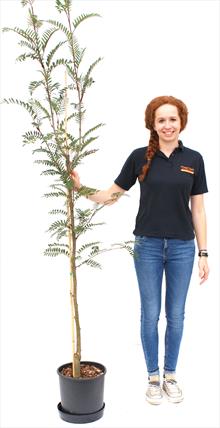Rosiness
Sorbus roseaAs the name suggests Sorbus rosea 'Rosiness' features candyfloss pink berries. The berries are quite large, and change colour through the autumn from pale to deeper pink. (This differs from some other white or pink-fruiting species, which tend to become whiter as autumn progresses).
The leaves of Rosiness fall relatively early in the autumn, leaving the berries exposed on bare branches into late autumn. The tree looks particularly attractive at this time of year.
This variety is difficult to produce and lacks the vigour of most other Sorbus species - the growth is weak, and it tends to remain a small tree, and we do not recomend it if you have less-than-perfect growing conditions. If in doubt then Sorbus Pink Charm or Eastern Promise are better choices.
Rosiness rowan trees for sale

All our pot-grown trees are grown for us to our specification by the Frank P Matthews nursery.
All pot-grown trees are suitable for planting out in the garden, some are suitable for growing in containers.
2-year pot-grown
tree
£73.00
Grown for us by Frank P Matthews nursery
In a 12L pot
Medium size (2.5m-3.5m after 10 years)
Next deliveries
Order now for delivery from week commencing 31st March.
How to grow
'Rosiness' can be planted in partial shade but for the best berry colours full sun is recommended.
'Rosiness' has a more spreading habit than most rowans, which tend to be quite upright.
History
The species Sorbus rosea is relatively new, and many varieties of this species were previously classified as Sorbus cashmiriana - originating from Kashmir. 'Rosiness' is still sometimes referred to as Sorbus cashmiriana 'Rosiness' by older authorities. Most varieties of Sorbus rosea have pink flowers and pink berries, and also pink-tinged shoots, and the pink coloration is more pronounced than in Sorbus cashmiriana. Both Sorbus cashmiriana and Sorbus rosea are small weak-growing species.
As the name suggests, 'Rosiness' was introduced by the University of Liverpool Ness Botanic Gardens.
Rosiness characteristics
- Gardening skillBeginner
- Attractive featuresAttractive flowersAttractive fruitAutumn foliage colour
- Growth habitUpright-spreading / Vase
- Height after 10 years2.5m-3.5m / 8ft-12ft
- SunlightPrefers full sunSome shade
- PruningLight prune
- Growth rateAverage
- Site conditionsCoastal siteOccasional flooding
- WildlifeAttractive to birds
- Flower colourPink - light
- Flowering monthJune
- Leaf colourGreen
- Leaf colour - autumnOrange / Red
- Fruit colourPink
- Fruit persistencePersistent
- Country of originUnited Kingdom
- Annual cycleDeciduous
Similar varieties
SorbusEastern PromiseA good alternative to Rosiness if you need a slightly more substantial tree.
Sorbus cashmirianaKashmir rowanThe Kashmir Rowan is a relative of Rosiness.
Sorbus vilmoriniiPink CharmOne of the best of the pink-berried Rowans.
SorbusPink NessAnother pink-berry rowan raised at Ness Botanic Gardens.
What will it look like?
Illustrative example of a pot-grown tree of this variety as supplied.
Approximate girth: 6/8cm. We try to keep all pot-grown trees down to about 1.5m as supplied, but some may be larger.
Trees should reach their mature height after about 10 or more years.

How to choose a Rowan or Whitebeam tree
We list more than 50 Sorbus (rowan and whitebeam) trees. Choosing can be difficult! Our article explaining the different berry and leaf colours might help narrow down the selection.
 Over 400 varieties of flowering cherries, crab apples, rowans and other ornamental trees.
Over 400 varieties of flowering cherries, crab apples, rowans and other ornamental trees.